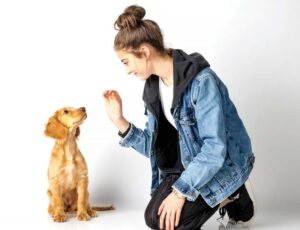While many people try their best to avoid coercion, accidental coercion can occur much easier than you might think. The trick to avoiding coercion when exposing puppies or dogs to something new is action first, then reinforcement.
Before we dive too deep into avoiding coercion, let’s talk about what coercion is and why we should avoid it when it comes to training our dogs. Coercion is the practice of persuading people or animals to do something by incentivizing them or threatening them in some way. Accidental coercion can occur when people use food or toys to guide their dog. This kind of incentivizing might feel natural. It is instinctual to grab food and guide dogs with it, and this isn’t always a bad thing. But when introducing dogs to a novelty or working through something that can be scary or uncomfortable, avoid guiding dogs with food.
When people guide a dog with food or toys the dog could start to associate the food or toy lure with new and scary things. For the dog this kind of luring can be confusing. Eventually the dog may stop forming positive associations with the food or toy and associate them with feelings of fear. We want dogs to make choices and we want to reward those choices rather than tricking them to go closer to something scary with food.
Ensure you aren’t relying on food or toys to get action to happen. Instead allow the dog to choose to take action, then reinforce those choices. Instead of using a food or a toy to lure a dog to do what I want, I guide with my hands and body first. Then once a dog takes an action, even if it is one small step towards what I am looking for, I reinforce the dog lavishly with its favorite treats and toys.
Introducing your dog or puppy to something new? Always remember, action first, then reinforcement. Our dogs will not only be able to form more positive associations when we avoid coercion, but they will likely become more confident and brave when trying new things when we avoid forcing them into it.



Loading Comments